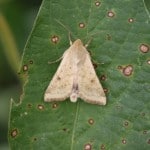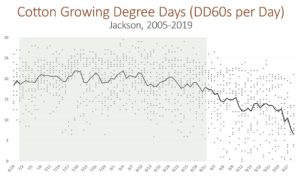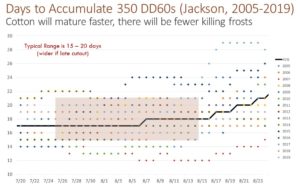
Sometimes there is no substitute for scouting. Spraying based on rumor or what your neighbor does will get you in trouble (or waste money). I predicted a relatively large corn earworm (bollworm) moth flight, but the average trap catches don’t support that. Having said that, there are definitely pockets of bollworms in late soybean and more widespread issues in cotton. Cotton maturity is all over the board depending on planting date, variety, and field conditions. The most mature cotton is past the point of caring about bollworms and other insect pests, having accumulated well over 350 DD60s since cutout (cutout = NAWF5). The latest cotton is just now approaching cutout and will need protection from insect pests for about three more weeks.
Reminder – August 15th is a pretty good estimate of the “last effective bloom date” for cotton in Tennessee. This represents the date that a flower has a 50% chance to make a pickable boll before a freeze. If your field has not cutout, I suggest using August 15th as the cutout date. I’ve included a chart below showing the average (and range) of DD60s cotton accumulates by date for Jackson, TN for the last 15 years. A second chart shows how many days it takes in an average year to accumulate 350 DD60s based on the date of cutout. If you look at this chart and use a cutout date of August 15th, you will see it takes about 16-20 days to accumulate 350 DD50s during an ‘typical’ year. This is one reason I suggest terminating all insecticide in the first week of September for cotton that was not cutout by August 15. By early September, every boll that has a good chance of maturing has likely accumulated 350 DD60s and should be relatively safe from insect attack.
I think it pretty unlikely that Bollgard 3, WideStrike 3, or TwinLink Plus cotton varieties will require treatment for bollworm. For fields of Bollgard II or TwinLink varieties, the insecticides I recommend depends on its maturity. There is an opportunity to “go cheap” on early cotton that only needs 7-10 days of protection. Specifically, I’m talking about a pyrethroid insecticide tank-mixed with Acephate, and this will also clean up any plant bugs or stink bugs. The diamides like Besiege (7-10 oz/a) or Prevathon (14-20 oz/a) are what I recommend in cotton that needs protected for a longer period of time. One final thought, don’t forget about fall armyworms in your Bollgard II cotton … there is more than usual pressure this year. The good news is that the above treatments above are pretty good, especially the diamides, and one overlooked benefit of having used Diamond for plant bug control during the past few weeks, is it typically keeps fall armyworm in check.
We are dealing with pockets of assorted caterpillars in soybean, but mostly green cloverworms, a smattering of armyworms, loopers and saltmarsh caterpillars, and bollworms in some very late maturing fields. However, there is nothing widespread, and extreme field to field variation is very common based on all sorts of factors such as planting date, maturity, rainfall patterns, etc. The point is you need to scout and refer to UT’s online resources related to soybean pest management, https://guide.utcrops.com/soybean/soybean-insect-guide/.



